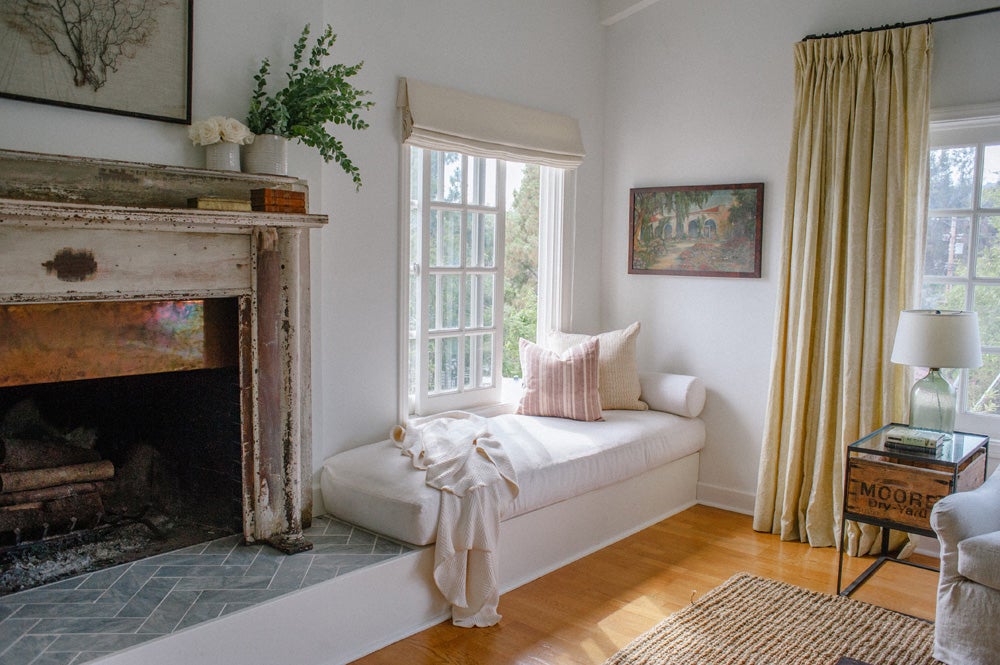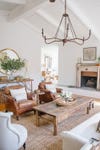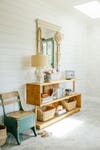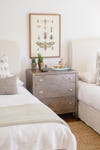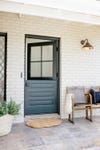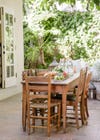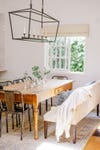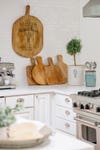This Home Blends Swedish Country With Cali-Cool, and Nails It
Tour an eco-friendly home full of antique furniture and gorgeous accents.
Published Sep 28, 2018 6:08 PM
We may earn revenue from the products available on this page and participate in affiliate programs.
Blending two aesthetics that are so distinctive in their own right is no easy feat—and so, it would seem that Ulrica Wihlborg had her work cut out for her when updating this Pacific Palisades home.
The Swedish-born People writer turned yoga instructor—take a peek at her seriously cool yoga studio in coastal Sweden—and her husband, entrepreneur Craig Forrest, bought the neglected 1964 ranch-style home to save it from being torn down. And while they fell in love with it the first time they stepped inside, the 2,400-square-foot home was in serious need of a little TLC.
The goal? To blend the Scandinavian simplicity of her background with touches from the California scene: natural materials, local designers, and accents paying homage to the history of the area.
“We decided to simply embrace its architectural style, fine tune its lines, and bring it back to its original glory—or better!” says Wihlborg. “We wanted subtle changes that still made a big difference. I really wanted to work with the roots of this house and make it come alive again.”
Over the course of a year, she worked to preserve the character of the home, all while giving it an eco-friendly facelift and bringing together two separate design styles. In Wihlborg’s own words, the goal was traditional, but unpretentious.
“The design was about unlocking the hidden potential of this forgotten California Ranch,” she explains. “We ended up with a home that feels very California from the inside out, with a tiny bit of Sweden blended in. It’s a place made for living, and sandy toes, and lots of light, and afternoon naps after a long day at the beach. It’s a house to be lived in, filled with details that I love and chose with my heart, and that makes it truly feel like home.”
Inside, Benjamin Moore’s crisp white Chantilly Lace provides a fresh backdrop for the home’s unique-looking pieces, allowing vintage furniture and even smaller decorative touches to truly take center stage. The kitchen, inspired by the Farmshop restaurant inside Brentwood Country Mart, feels simultaneously rustic and sophisticated—which is actually a good way to describe the final aesthetic of the entire home. An overall light, breezy feel balances out the more antique-looking pieces, and plants the home firmly in its California roots. The entire space is both laid-back and refined.
“My goal was to create a home that felt lived in right from the start, and maybe even got better with age. I love design that you can live with for a long time, and I honestly don’t like shopping that much. Everything has to feel as it came from a good, happy place. If there’s a sweet story behind it, even better,” says Wihlborg.
We spoke to Wihlborg to hear her own sweet story on how she created a home for her family, blending her Swedish roots with the breezy California surroundings.
What was your style inspiration for the project? Did you reference anything specific?
I’m a huge fan of Kathryn M. Ireland because I love how whimsical and fun her homes are. They feel lived in! Her book Creating a Home was an inspiration to me and something I referenced. Another inspiration was the store Rooms and Gardens in Santa Monica, and I purchased a lot of accessories from them. I also find Pinterest to be a great tool; I created Pinterest boards for each room—not only to design each room individually, but to help create a cohesive feeling for the entire house.
My main design technique was to do white walls throughout the entire house and keep the major furniture pieces upholstered in white or flax linen. Then, [I added] texture with vintage furniture pieces and fabrics from a few select designers. That way, I created consistency throughout the house, while still giving each room character.
What did your wishlist look like?
I’ve wanted a Cisco Home Genevieve sofa and O’Hara bed for so long. I had pinned the Native Trails farmhouse sink to my Pinterest board years before we bought this house, so that was another thing I really wanted to incorporate. Textiles from Kathryn M. Ireland and Raoul Textiles were always at the top of my wishlist, and that included custom roman shades and drapery for every window in the house. Finding someone who is good at custom window treatments is really hard, unless you’re a professional designer! My friend Claudia Clobes Yudis of Urban Loft Window Treatments made all the beautiful window treatments for the house, so everything you see is made by her.
Can you tell us a bit about all the natural materials used in the home—was texture a big priority for you?
Texture was important to me, and I wanted everything to be made of natural materials like linen, cotton, jute, wood, and a little metal. I feel if you mix natural materials, you can’t go wrong. I did simple jute rugs in almost all the rooms (except a few vintage, handknotted rugs I bought from The Found Shop). All my drapery is linen, and most of the furniture is upholstered in linen.
We love the antique feel of the furniture in the home. Where are your favorite places to source these pieces?
My friend Jeni Maus owns Found Rentals, a large vintage rental company in California. She sources antique furniture and vintage pieces from all over the world—mainly from France—and she has amazing taste. She has a shop where she sells some of her vintage and antique finds, The Found Shop, and she ships all over the US. I went to lots of flea markets, but it was really hard to find good vintage furniture that is both functional and beautiful, so Found Shop saved me. And since their pieces [are] mostly from France, it made the furniture feel like it belonged together.
The two folding chairs that are on the front porch have a fun story behind them. I found them in an old barn in my hometown of Karlshamn in Sweden. They were originally from the Town Hall, built in 1898, but when they remodeled it, they ripped out hundreds of these old folding chairs. I bought two of them for $25, disassembled them, and had my husband carry them with him in a hockey bag on one of his trips to LA. They now fit perfectly in that little space on the porch, and thanks to them, that area has turned into a little hangout space for our family in the afternoons. Plus, I love that we have a little piece of our Swedish hometown in our house in California.
I brought a few vintage canvas oil paintings with me from Sweden. They’re not worth much, but I love the color and subject matter. The little green oil painting I have in the kitchen is my favorite—it’s easy on the eye, and adds a little touch of color. You can often find these little oil paintings at local flea markets, and they usually don’t cost much. Just remove the frame (if there is one) and hang it up for a cute detail.
How does the home pay homage to California history and design?
You often see these old California ranch homes either being torn down and replaced by McMansions, or completely renovated and converted into craftsman-style homes. When we first bought the house, a mutual friend showed it to preservationist Brett Waterman, the host of DIY Networks’ Restored. He loved it, and felt strongly that we should embrace its origins. And in a way, that approach worked out perfectly because most of my favorite designers are from California. I loved that I could merge everything—interiors and exteriors—into one! I also like design to be pretty relaxed and simple, so that worked well with the house’s easygoing architecture.
In what way is it a tribute to your Swedish roots?
No window screens! Just kidding. I did remove all the window screens as soon as we bought the house—in Sweden, we don’t have window screens, and I love the look of clean windows. Then, of course, the mosquitoes attacked us, so I had to put at least some of them back.
But seriously, Swedish design is overall very clean and monochromatic. White is big! There’s not a lot of room for clutter or texture or crazy color combinations. That’s also a challenge, because it tends to hold me back from making more brave choices in terms of design.
I’ve also brought some things to the house that my mom and grandmother gave me, like a painting in my daughter’s room and vintage books. It makes it feel like a real home to me, and reminds me of the two places I love the most.
How did you blend the two styles?
I find California and Swedish design to be very complementary. I love the relaxed feel of California design, and the use of texture and influences from so many different cultures. I also love the more substantial feel of California furniture; [it’s] more comfortable than Swedish minimalist design.
On the other hand, you have Swedish minimalism and clean lines, which is also very pretty and relaxing. So, if you mix the clean lines of Swedish design and its love of whites with the more relaxed, textured feel of California design, it creates a pretty fresh, happy look.
Can you tell us about your focus on sustainability, and how you used eco-friendly materials in the home?
We tried to preserve whatever was there as long as it was made of solid material, deciding to refurbish a lot of details, instead of replacing them. And whenever we brought in new materials, we made sure they were eco-friendly. We also tried to make sure everything was sustainably harvested wood.
The deck we built outside the main bedroom was also a great decision in terms of making the home eco-friendly. I had treated our deck in Sweden with a wood treatment product called OrganoWood—which is a Swedish invention—and I wanted to use it again because it worked so [well]. It’s an environmentally-friendly wood [protector] which mimics the natural fossilization process, creating a deck that’s weather protected, but 100 percent free from biocides and heavy metals. It’s scheduled to launch in the US later this year. You can actually drink the treatment, although I wouldn’t recommend it!
Did you find any challenges with the home?
I really wanted this house to feel like our family’s home right away, which was probably the biggest challenge since I started from scratch. I didn’t even have any books, and books are my life! I didn’t have any framed photographs or treasured memories to put in this home. All those things we cherish and usually bring from home to home when we move through life, I had already sent to my home in Sweden when we moved from LA to Sweden five years ago.
Speaking of your home in Sweden, did you approach this design project any differently, given that you don’t live in this LA home full-time?
I had a ton of time to just sit and plan the layout. Since we didn’t have to live there immediately with our kids, it gave me time to really think about what I wanted to do. It was kind of lovely to have this project to work on while getting through the Swedish winter!
Once the floor plan was done, it was pretty hectic because I could only look for furniture and accessories while we were there. Things don’t always look quite the way you think when you order them online, so I made a few expensive mistakes that I wasn’t able to return. I ended up picking [out] almost everything in person, which was time consuming, and since I didn’t have a lot of time during our visits, that was hard.
Do you have a favorite part of the home?
The reading nook we built next to the fireplace underneath the window. It’s become the place where we all want to hang out in the afternoon, with the sun streaming in through that window and the breeze coming in from the ocean. It’s the perfect little reading nook, and if you’re lucky, you might even get to take a little nap in the afternoon sun.
Photography by Heidi Zumbrun.
See more home tours:
A Boldly Beautiful Brooklyn Heights Home That Encourages Ultimate Zen How One Designer Adds Character to Her Newly-Built HomeA Family That Uses Their Home as an Art Gallery
Learn to love your inbox again—sign up for Domino’s daily email.
